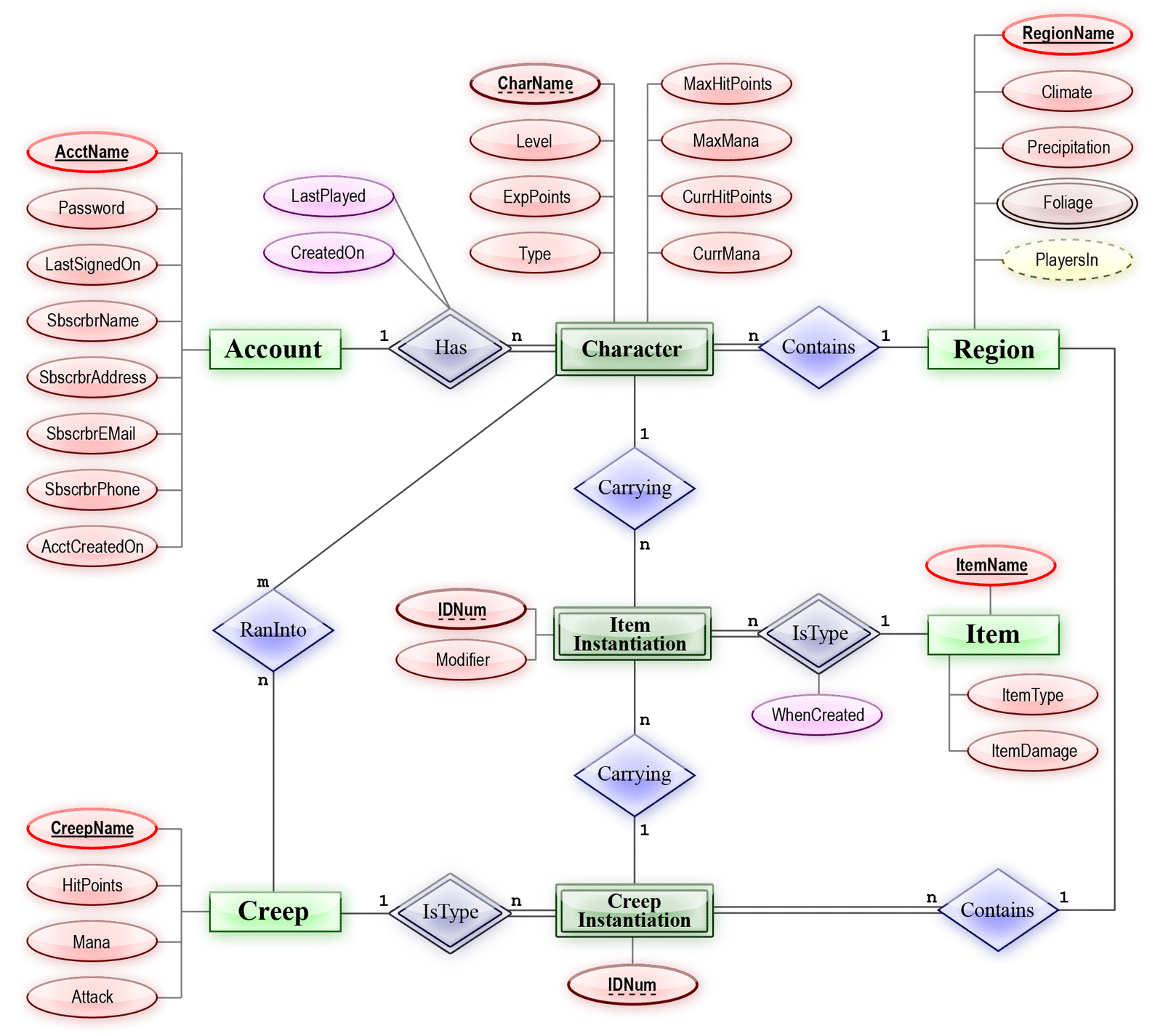|
Many-to-many (data Model)
In systems analysis, a many-to-many relationship is a type of cardinality that refers to the relationship between two entities, say, A and B, where A may contain a parent instance for which there are many children in B and vice versa. Data relationships For example, think of A as Authors, and B as Books. An Author can write several Books, and a Book can be written by several Authors. In a relational database management system, such relationships are usually implemented by means of an associative table (also known as join table, junction table or ''cross-reference table''), say, AB with two one-to-many relationships and . In this case the logical primary key for AB is formed from the two foreign keys (i.e. copies of the primary keys of A and B). In web application frameworks such as CakePHP and Ruby on Rails, a many-to-many relationship between entity types represented by logical model database tables is sometimes referred to as a HasAndBelongsToMany (HABTM) relationship. ... [...More Info...] [...Related Items...] OR: [Wikipedia] [Google] [Baidu] [Amazon] |
Systems Analysis
Systems analysis is "the process of studying a procedure or business to identify its goal and purposes and create systems and procedures that will efficiently achieve them". Another view sees systems analysis as a problem-solving technique that breaks a system down into its component pieces and analyses how well those parts work and interact to accomplish their purpose. The field of system analysis relates closely to requirements analysis or to operations research. It is also "an explicit formal inquiry carried out to help a decision maker identify a better course of action and make a better decision than they might otherwise have made." The terms analysis and synthesis stem from Greek, meaning "to take apart" and "to put together", respectively. These terms are used in many scientific disciplines, from mathematics and logic to economics and psychology, to denote similar investigative procedures. The analysis is defined as "the procedure by which we break down an intellectual ... [...More Info...] [...Related Items...] OR: [Wikipedia] [Google] [Baidu] [Amazon] |
Cardinality (data Modeling)
Within data modelling, cardinality is the numerical relationship between rows of one table and rows in another. Common cardinalities include ''one-to-one'', ''one-to-many'', and ''many-to-many''. Cardinality can be used to define data models as well as analyze entities within datasets. Relationships For example, consider a database of electronic health records. Such a database could contain tables like the following: * A doctor table with information about physicians. * A patient table for medical subjects undergoing treatment. * An appointment table with an entry for each hospital visit. Natural relationships exist between these entities: * A many-to-many relationship between records in doctor and records in patient because doctors have many patients and patients can see many doctors. * A one-to-many relationship between records in patient and records in appointment because patients can have many appointments and each appointment involves only one patient. * A one-to-one rela ... [...More Info...] [...Related Items...] OR: [Wikipedia] [Google] [Baidu] [Amazon] |
Entity
An entity is something that Existence, exists as itself. It does not need to be of material existence. In particular, abstractions and legal fictions are usually regarded as entities. In general, there is also no presumption that an entity is Life, animate, or present. The verb tense of this form is to 'entitize' - meaning to convert into an entity; to perceive as tangible or alive. The term is broad in scope and may refer to animals; natural features such as mountains; inanimate objects such as tables; numbers or sets as symbols written on a paper; human contrivances such as laws, corporations and academic disciplines; or supernatural beings such as gods and spirits. The adjectival form is ''entitative''. Etymology The word ''entity'' is derived from the Latin ''entitas'', which in turn derives from the Latin ''ens'' meaning "being" or "existing" (compare English ''essence''). ''Entity'' may hence literally be taken to mean "thing which exists". In philosophy Ontology is th ... [...More Info...] [...Related Items...] OR: [Wikipedia] [Google] [Baidu] [Amazon] |
Entity–relationship Model
An entity–relationship model (or ER model) describes interrelated things of interest in a specific domain of knowledge. A basic ER model is composed of entity types (which classify the things of interest) and specifies relationships that can exist between entities (instances of those entity types). In software engineering, an ER model is commonly formed to represent things a business needs to remember in order to perform business processes. Consequently, the ER model becomes an abstract data model, that defines a data or information structure that can be implemented in a database, typically a relational database. Entity–relationship modeling was developed for database and design by Peter Chen and published in a 1976 paper, with variants of the idea existing previously. Today it is commonly used for teaching students the basics of database structure. Some ER models show super and subtype entities connected by generalization-specialization relationships, and an ER model can ... [...More Info...] [...Related Items...] OR: [Wikipedia] [Google] [Baidu] [Amazon] |
Hierarchy
A hierarchy (from Ancient Greek, Greek: , from , 'president of sacred rites') is an arrangement of items (objects, names, values, categories, etc.) that are represented as being "above", "below", or "at the same level as" one another. Hierarchy is an important concept in a wide variety of fields, such as architecture, philosophy, design, mathematics, computer science, organizational theory, systems theory, systematic biology, and the social sciences (especially political science). A hierarchy can link entities either directly or indirectly, and either vertically or diagonally. The only direct links in a hierarchy, insofar as they are hierarchical, are to one's immediate superior or to one of one's subordinates, although a system that is largely hierarchical can also incorporate alternative hierarchies. Hierarchical links can extend "vertically" upwards or downwards via multiple links in the same direction, following a path (graph theory), path. All parts of the hierarchy that are ... [...More Info...] [...Related Items...] OR: [Wikipedia] [Google] [Baidu] [Amazon] |
RDBMS
A relational database (RDB) is a database based on the relational model of data, as proposed by E. F. Codd in 1970. A Relational Database Management System (RDBMS) is a type of database management system that stores data in a structured format using rows and columns. Many relational database systems are equipped with the option of using SQL (Structured Query Language) for querying and updating the database. History The concept of relational database was defined by E. F. Codd at IBM in 1970. Codd introduced the term ''relational'' in his research paper "A Relational Model of Data for Large Shared Data Banks". In this paper and later papers, he defined what he meant by ''relation''. One well-known definition of what constitutes a relational database system is composed of Codd's 12 rules. However, no commercial implementations of the relational model conform to all of Codd's rules, so the term has gradually come to describe a broader class of database systems, which at a minim ... [...More Info...] [...Related Items...] OR: [Wikipedia] [Google] [Baidu] [Amazon] |
Associative Entity
An associative entity is a term used in relational and entity–relationship theory. A relational database requires the implementation of a base relation (or base table) to resolve many-to-many relationships. A base relation representing this kind of entity is called, informally, an associative table. As mentioned above, associative entities are implemented in a database structure using associative tables, which are tables that can contain references to columns from the same or different database tables within the same database. An associative (or junction) table maps two or more tables together by referencing the primary keys (PK) of each data table. In effect, it contains a number of foreign keys (FK), each in a many-to-one relationship from the junction table to the individual data tables. The PK of the associative table is typically composed of the FK columns themselves. Associative tables are colloquially known under many names, including association table, bridge ... [...More Info...] [...Related Items...] OR: [Wikipedia] [Google] [Baidu] [Amazon] |
Primary Key
In the relational model of databases, a primary key is a designated attribute (column) that can reliably identify and distinguish between each individual record in a table. The database creator can choose an existing unique attribute or combination of attributes from the table (a natural key) to act as its primary key, or create a new attribute containing a unique ID that exists solely for this purpose (a surrogate key). Examples of natural keys that could be suitable primary keys include data that is already by definition unique to all items in the table such as a national identification number attribute for person records, or the combination of a very precise timestamp attribute with a very precise location attribute for event records. More formally, a primary key is a specific choice of a minimal set of attributes that uniquely specify a tuple ( row) in a relation (table). A primary key is a choice of a candidate key (a minimal superkey); any other candidate key is an ... [...More Info...] [...Related Items...] OR: [Wikipedia] [Google] [Baidu] [Amazon] |
Foreign Key
A foreign key is a set of attributes in a table that refers to the primary key of another table, linking these two tables. In the context of relational databases, a foreign key is subject to an inclusion dependency constraint that the tuples consisting of the foreign key attributes in one relation, R, must also exist in some other (not necessarily distinct) relation, S; furthermore that those attributes must also be a candidate key in S. In other words, a foreign key is a set of attributes that a candidate key. For example, a table called TEAM may have an attribute, MEMBER_NAME, which is a foreign key referencing a candidate key, PERSON_NAME, in the PERSON table. Since MEMBER_NAME is a foreign key, any value existing as the name of a member in TEAM must also exist as a person's name in the PERSON table; in other words, every member of a TEAM is also a PERSON. Summary The table containing the foreign key is called the child table, and the table containing the candidate ke ... [...More Info...] [...Related Items...] OR: [Wikipedia] [Google] [Baidu] [Amazon] |
Web Application Framework
A web framework (WF) or web application framework (WAF) is a software framework that is designed to support the development of web applications including web services, web resources, and web APIs. Web frameworks provide a standard way to build and deploy web applications on the World Wide Web. Web frameworks aim to automate the overhead associated with common activities performed in web development. For example, many web frameworks provide libraries for database access, templating frameworks, and session management, and they often promote code reuse. Although they often target development of dynamic web sites, they are also applicable to static websites. History As the design of the World Wide Web was not inherently dynamic, early hypertext consisted of hand-coded HTML text files that were published on web servers. Any modifications to published pages needed to be performed by the pages' author. In 1993, the Common Gateway Interface (CGI) standard was introduced for inte ... [...More Info...] [...Related Items...] OR: [Wikipedia] [Google] [Baidu] [Amazon] |


